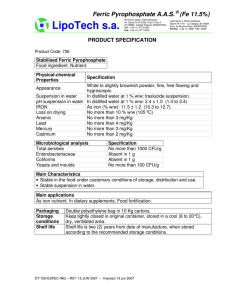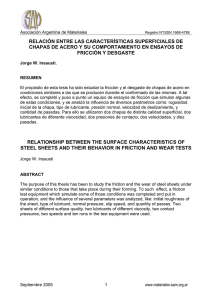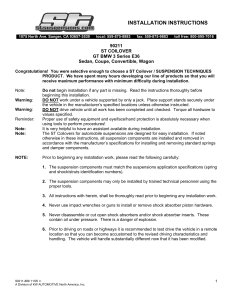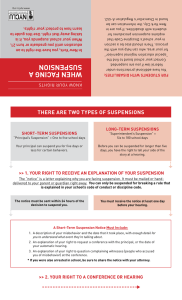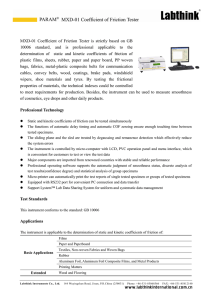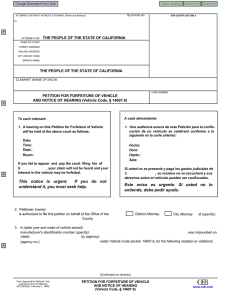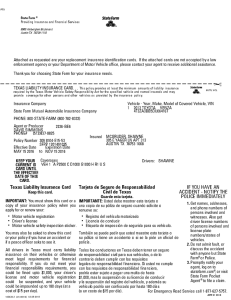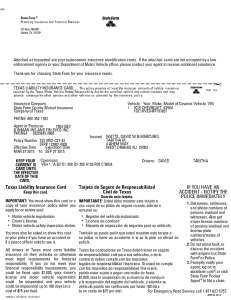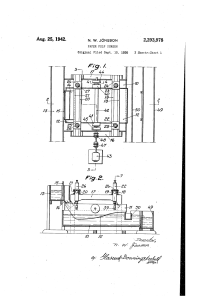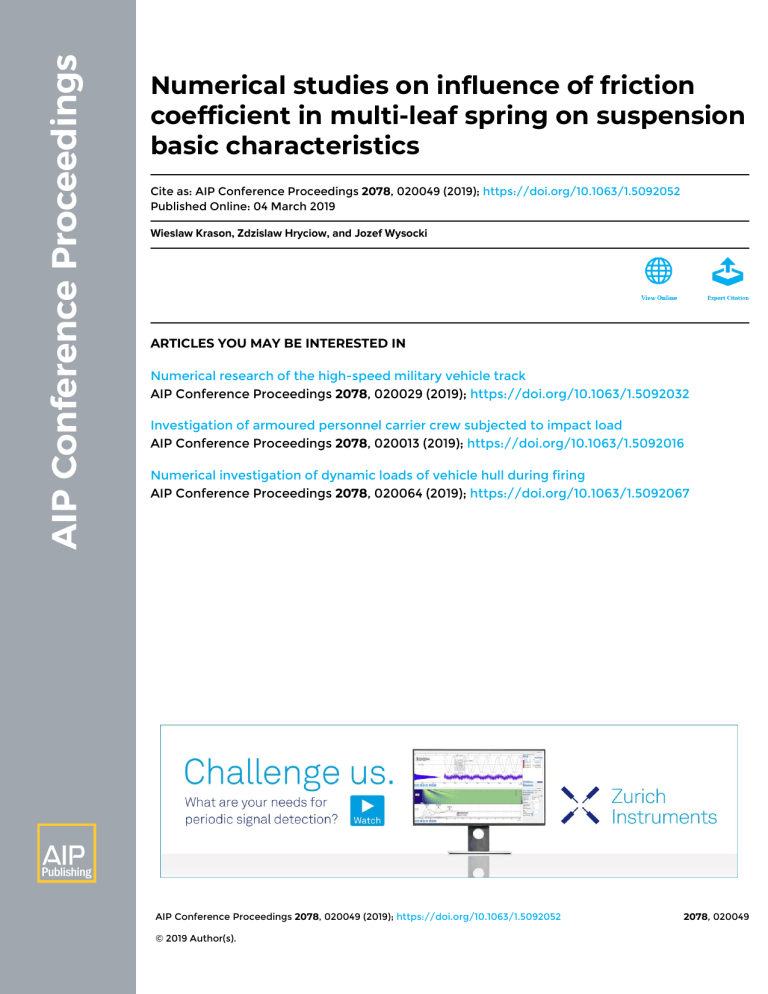
Numerical studies on influence of friction coefficient in multi-leaf spring on suspension basic characteristics Cite as: AIP Conference Proceedings 2078, 020049 (2019); https://doi.org/10.1063/1.5092052 Published Online: 04 March 2019 Wieslaw Krason, Zdzislaw Hryciow, and Jozef Wysocki ARTICLES YOU MAY BE INTERESTED IN Numerical research of the high-speed military vehicle track AIP Conference Proceedings 2078, 020029 (2019); https://doi.org/10.1063/1.5092032 Investigation of armoured personnel carrier crew subjected to impact load AIP Conference Proceedings 2078, 020013 (2019); https://doi.org/10.1063/1.5092016 Numerical investigation of dynamic loads of vehicle hull during firing AIP Conference Proceedings 2078, 020064 (2019); https://doi.org/10.1063/1.5092067 AIP Conference Proceedings 2078, 020049 (2019); https://doi.org/10.1063/1.5092052 © 2019 Author(s). 2078, 020049 Numerical Studies on Influence of Friction Coefficient in Multi-Leaf Spring on Suspension Basic Characteristics Wieslaw Krason1, a), Zdzislaw Hryciow2, b) and Jozef Wysocki2, c) 1 Military University of Technology, Faculty of Mechanical Engineering, Department of Mechanics and Applied Computer Sciences. 2 Military University of Technology, Faculty of Mechanical Engineering, Institute for Motor Vehicles and Transport. a) Corresponding author: [email protected] b) [email protected] c) [email protected] Abstract. The results of numerical analyses for a 3D model of a dependent vehicle suspension equipped with a multi-leaf spring (with a shackle) are presented in the paper. Friction between the feather surfaces and the impact of the sprung and the unsprung mass of a vehicle suspension are taken into account during tests. The influence of elastic and damping properties of tires as well as the impact of viscous damping are omitted in the considerations. This approach considerably simplifies the analysis of the calculation results. The kinematic excitation originating from the micro-profile of road irregularities is assumed to be a sinusoid with the given parameters (amplitude and frequency). Tests of the force impact, for the assumed values of static and kinetic friction coefficients, on the quality of suspension work are included in the multivariate numerical tests. The simulation results are presented in the form of vibrations time courses of the sprung and unsprung mass as well as tabulations of the vibration transmission factor. This parameter is used to assess the suspension quality (the degree of vibration isolation). The tests are carried out in the LS-DYNA system. INTRODUCTION A wide application of multi-leaf springs in the dependent suspension of trucks and trailers causes the focus of the research effort on determining the elastic and damping characteristics. The influence of these characteristics on vibrations and dynamic loads of its basic assemblies and systems (body, suspension system, carrier etc.) is also investigated. Discrete car vibration models describing its vertical vibrations [3, 9, 10] are frequently used in the analysis of physical phenomena occurring in the selected elements, parts, assemblies and the entire vehicle. For example, the effects of generalized forces for the flat system as well as vertical and angular vibrations are considered for the analysis of dynamic loads of the suspension in the vehicle longitudinal plane [3, 9, 10]. Frequently, a series of simplifications in the construction of models, for example small vibrations of the body and road wheels, are considered. A fixed and constant contact between the tire wheel and the surface, constant rolling resistance coefficient, linearity of the elastic and damping characteristics with omitting significant friction sources in vehicle suspension, etc., are introduced in order to facilitate the vibration analysis. It was also found that for a large group of construction solutions for two-axle vehicles, the dependence is quite frequently met that the coefficient of distribution of sprung mass (ε ≈ 1) is close to or equal to one. The coefficient of sprung masses distribution is described by the dependence (1) according to [9, 10]. ε = ρ 2 /(d r ⋅ d f ) where: ρ – radius of the car sprung mass inertia, df (dr) – distance between the sprung mass centre and the front (rear) axis. Computational Technologies in Engineering (TKI’2018) AIP Conf. Proc. 2078, 020049-1–020049-6; https://doi.org/10.1063/1.5092052 Published by AIP Publishing. 978-0-7354-1806-6/$30.00 020049-1 (1) When the above condition is met, the front or rear suspension can be analyzed independently. The detailed spring models developed using the finite element method can be found in addition to the discrete models of the entire vehicle. Different approaches to modeling the vehicle suspension as well as elastic and damping elements are presented in literature [3–7]. The results of numerical analyses of multi-leaf springs from a simple three-part model to multi-object models are presented in works [5–7]. The presented models have different levels of complexity and accuracy, and consequently a different amount of work in their development and the required calculation time. Dynamic properties of the multi-leaf spring used in a suspension of the light commercial vehicle in terms of driving comfort are investigated in work [1]. An influence of friction, frequency and amplitude of vibrations on spring dynamic stiffness is assessed. The work proved that the reduction of friction between leaf springs is the most effective way to improve the stiffness of the dynamic multi-leaf spring. An estimation of the total force generated by a leaf spring as the sum of force vectors derived from elastic force and dry friction is proposed in paper [2]. The spring model, which does not take into account an impact of the change in relative velocities on the friction surfaces of leaf springs is adopted. The hysteresis in this model is strongly non-linear. The results of numerical analyses are verified with the experimental tests carried out on a truck. Noteworthy is also article [3]. The authors focus on the “multibody” approach and the finite element method (FEM) using to find a compromise between accuracy and a computational speed. A variant of a multibody numerical model as a multibody model built in LMS Virtual. Lab Motion [3] is proposed. Each leaf spring is discretized in the form of several rigid bodies joined by linear elastic beams. A contact between individual leaves is simplified to a numerical model of interaction between the balls. The approach with contact areas known a priori [4] is advantageous for it significantly improves a computational efficiency. Friction between the leaf springs has a very large impact on the vibration parameters of the vehicle suspension, especially on the dry friction effect [3, 8–12]. A necessary condition for the analysis of vibrations and dynamic loads of the suspension system (vehicle) [3–8, 11] is, therefore, taking into account the friction in modern methods for designing and diagnosing the multi-leaf springs. A 3D model of a dependent vehicle suspension equipped with a multi-leaf spring (with a shackle), which takes into account the friction between the feather surfaces and the impact of the sprung mass and the unsprung vehicle suspension, is developed in the work. The impact of elastic and damping properties of the tires and the effect of viscous damping are omitted in the model. The impact of force, for the assumed values of static and kinetic friction coefficients, on the quality of suspension work is determined as a result of the tests. The level of dynamic loads of the vehicle body and selected suspension units is additionally determined AIM AND SCOPE OF TESTS The paper focuses on developing a 3D model of a vehicle dependent suspension according to FEM. The numerical model includes a detailed solid model of a multi-leaf spring with a shackle and a part of the body mapped in the form of a rigid body. An influence of tires and viscous damping was omitted in the considerations. Values of the friction coefficients are adopted on the basis of literature data [8]. The excitation of the tested suspension model is a function of time describing road irregularities in the form of a sinusoid with given parameters (amplitude and frequency). A determination of the load impact with a fixed surface condition of the leaf springs (coefficient of friction between the leaves) on the ability of the suspension to reduce the level of vibration transmitted on the vehicle body is the purpose of this work. FE numerical analyses of the motion of vibrating mass representing the truck body for various variants are performed with changing conditions of the leaf springs interaction. The changes concerned three variants of static and kinetic friction coefficients associated with the basic friction pair of leaf springs. Selected simulation results are presented in the form of time courses of the sprung and unsprung mass vibrations as well as tabulations of a vibration transmissibility coefficient which is used to assess the suspension quality (the level of vibroisolation). MODEL RESEARCH On the basis of the working conditions analysis of the multi-leaf spring, it can be clearly stated that conditions of cooperation between individual leaves change during the spring operation [12]. The graphite grease layer is usually between the leaves in the initial state [11]. It is gradually removed during work and the nature of work approaches the conditions of dry friction. A layer of oxides appears in addition on the surfaces of the leaves. Therefore, the paper attempts to estimate an influence of static and kinetic friction coefficients on the amount of energy dissipated in the spring, as well as the quality of the vibration isolation system during the vehicle motion on 020049-2 an uneven ground. A simulation model consisting of a quadrant of the car’ body modeled as a rigid body, a multileaf spring and connecting elements – an eye and a shackle (Fig. 1) is used in the numerical analysis. The considered spring consists of seven leaves. 8-node solid elements are used to build the spring model. In total, the numerical model consists of about 12.000 elements. A contact with friction forces has been defined between the leaves. A friction coefficient is calculated based on dependence (2) in the LS-DYNA system [13]: μ = μ k + ( μ s − μ k ) ⋅ e −γ ⋅v rel (2) where: µs – static coefficient of friction, µk – kinetic coefficient of friction, γ – exponent determining the change of coefficients as a function of relative velocity, vrel – relative velocity of cooperating surfaces. FIGURE 1. 3D model of the dependent suspension according to FEM: 1 – rigid body part, 2 – conventional multi-leaf spring, 3 – spring shackle, CG – mass center of the body (1), za(t) – kinematic excitation, zb(t) – displacement of a rigid body (a system response) The calculations were carried out in two stages. In the initial phase it was necessary to compress the leaves in the middle part, due to different radii of individual leaves. This ensured the introduction of initial stresses and the emergence of pressure forces between the leaves (generating, among others, the friction forces). The behavior of the spring and vehicle body during driving on an uneven ground was determined in the second stage of analysis. They are mapped by the kinematic excitation applying to the central part of the spring (driving axle) described with relationship (3): z a (t ) = z o ⋅ [1 − cos(2 ⋅ π ⋅ f ⋅ t )] (3) Excitation frequencies are selected to analyze the behavior of the vibration system in the sub-resonance and super resonant areas [14]. Therefore, the natural vibration frequency (1.67 Hz) was determined for the suspension model (Fig. 1) in the static equilibrium position. Two frequencies f = 1 and 5 Hz with amplitude values of 3 and 6 mm were assumed for each of them in the next part of simulation tests. The quality of suspension work (level of vibroisolation) was determined by T transmissibility coefficient as a comparison of the root mean square values of vibration accelerations for different associations between the cooperating spring leaves (different values of the friction coefficient): T= RMS b RMS a (4) where: RMSa and RMSb – root mean square values of accelerations at points a (driving axle) and b (vehicle body). 020049-3 To identify the suspension quality, a logarithmic scale to determine E effectiveness of vibroisolation (effectiveness of the isolator) based on dependence (5) can be applied. The effectiveness of the isolator is expressed in dB: 1 E = 20 ⋅ log T (5) The calculations were carried out for three variants of friction coefficients corresponding to possible friction associations (surface states) of leaf springs, namely, pure and dry covered with graphite grease and covered with a thin layer of oxides. The values of a static and a kinetic coefficient of friction used in the numerical studies are shown in Table 1. Friction coefficients Static, µs Kinetic, µk TABLE 1. Coefficients of a static and a kinetic friction [8] The surface condition of leaf springs Dry, clean Covered with graphite grease 0.78 0.42 0.11 0.058 Dry, covered with rust 0.27 0.14 RESEARCH RESULTS The results of the suspension model tests in the form of vertical acceleration graphs of the central spring fragment (point a – Fig. 1) and vertical accelerations of the vehicle body (point b – Fig. 1) for three surface conditions of the leaf springs, obtained for the excitation with an amplitude zo = 3 mm and frequencies f = 1 and 5 Hz, are shown in Fig. 2. FIGURE 2. The suspension model vertical accelerations determined for excitation with an amplitude of zo = 3 mm and two frequencies: f = 1 Hz (left), f = 5 Hz (right) and considering the leaves surface conditions Based on the model vibration analysis for the super resonant frequency (f = 5 Hz), it is found that introducing the lubricant between the cooperating leaves reduced an effective value of the vehicle body acceleration by approximately 2.25 and a vibration transmission coefficient T decreased from 0.27 to 0.12, compared to the spring vibrations with both clean and dry leaf surfaces. However, for the subresonant frequency (f = 1 Hz), the opposite effect is observed, and introducing the lubricant resulted in the greatest increase in the value of the generated accelerations. The numerical analysis results describing the excitation impact on the vibration transmissibility coefficient (T) and the effectiveness of the isolator (E) are shown in Table 2 for the considered variants. For super resonance frequencies, the largest decrease in an effective value of vertical accelerations is observed for the spring with the leaves covered with a layer of grease and the smallest for a dry, clean, steel surface. A greater improvement in vibration isolation is observed for a smaller amplitude. The vibration transmissibility coefficient is increased and, thus, the vibration isolation efficiency is reduced by increasing the amplitudes of vibrations. For the subresonant frequencies (f = 1 Hz), an increase of an effective value of the vehicle body accelerations in relation to the 020049-4 accelerations of the drive bridge (point a – input of the considered system, Fig. 1) is observed for all the analyzed variants. In this case, the opposite trend is noted to the one described above. Decreasing the coefficient of friction as well as decreasing the amplitude of vibrations causes an increase in the values of accelerations. TABLE 2. Comparison of the test results T – Transmissibility E – Effectiveness of the Isolator [dB] Excitation Parameters Frequency f [Hz] Amplitude zo [mm] Covered with graphite grease Covered with rust, dry Clean, Dry Covered with graphite grease Covered with rust, dry Clean, Dry 1 1 5 5 3 6 3 6 1.39 1.54 0.12 0.11 1.06 1.26 0.14 0.12 1.05 1.05 0.27 0.17 –2.87 –3.77 18.44 19.13 –0.54 –2.00 16.98 18.67 –0.42 –0.40 11.47 15.42 An influence of a change in the friction coefficient and the vibrations amplitude (zo = 3 mm and zo = 5 mm) on the values of the vibration transmissibility coefficient (T) for the excitation frequency f = 1 Hz (Fig. 3a) and f = 5 Hz (Fig. 3b) is presented in Fig. 3 to complement the numerical results. 1,8 0,3 zo = 3 mm, f = 1 Hz zo = 3 mm, f = 5 Hz 0,25 zo = 6 mm, f = 1 Hz 1,4 Transmissibility, T Transmissibility, T 1,6 1,2 1 0,8 0,6 0,4 zo = 6 mm, f = 5 Hz 0,2 0,15 0,1 0,05 0,2 0 Covered with graphite grease Covered with rust, dry Clean, Dry 0 Covered with graphite Covered with rust, dry grease Clean, Dry Surface condition Surface condition (a) (b) FIGURE 3. Vibration transmissibility coefficient (T) for excitation with frequency f = 1 Hz (left) and f = 5 Hz (right) and amplitude values: zo = 3 and 6 mm for the analyzed frictional pair Distributions of HMH stresses in individual leaf springs for excitation with 3 mm amplitude operating at 5 Hz frequency are additionally illustrated in Fig. 4a. They are mainly caused by compressing the leaves through the pulling screw. The highest stress values are observed in the middle part of the spring, especially the shortest leaf. Figure 4b presents the distribution of contact force between the leaf spring. Based on the distribution of contact force, it is found that the main interaction between the leaves occurs at their ends. This is confirmed by observations of the experimental results [4]. The increased heating of leaves as well as intensive wear of their surfaces was found in these areas [4, 12]. CONCLUSIONS Based on the obtained results, it was found that the vibration transmissibility coefficient (T) depends not only on the leaf springs surface condition, but also on the parameters of the excitation (amplitude and frequency). There may appear a phenomenon of blocking the leaf springs, in particular for small kinematic excitations from the road side. Such a phenomenon is observed for roads in a condition with a very small amplitude of the road micro-profile in real conditions of vehicle operation for the vehicle suspension in a poor condition caused by negligence of a periodic technical service [9, 10]. As a consequence, the vibrations from the drive axle on the vehicle body are transmitted directly. The results of numerical analysis also indicates a high impact of the leaf springs surface condition on the vehicle body acceleration values. Operational negligence can increase the acceleration values by several times and an undesirable phenomenon, from the point of view of smooth traffic and passenger ride comfort, occurs. 020049-5 (a) (b) FIGURE 4. HMH stress [σmax = 500 MPa] specified in the leaf spring (a) and contact forces [Fmax = 500 N] determined between the spring leafs (b) for excitation with frequency f = 5 Hz and amplitude zo = 3 mm ACKNOWLEDGEMENT The works were carried out as part of the research project PBS 23-937, Military University of Technology, 2016-2018. REFERENCES 1. 2. 3. 4. 5. 6. 7. 8. 9. 10. 11. 12. 13. 14. Z. Zhou, W. Guo, T. Shen, F. Wang, J. Ju, H. Wang, and E. Song, “Research and Application on Dynamic Stiffness of Leaf Spring,” in World Automotive Congress, SAE-China, FISITA 2012, 10, (2012) pp. 105–119. A. Clavel, M. Sorine, and Q. Zhang, IFAC Proceedings Volumes 34, 1, 307–312 (2001). A. Toso, U. Facchin, and S. Melzi, “Multibody and Finite Element models of a leaf-spring suspension for vehicle dynamics applications: numerical model, tests and correlation,” in ECCOMAS Thematic Conference on Multibody Dynamics, (Barcelona, Catalonia, Spain, 2015). W. Krason and J. Wysocki, Friction and Wear 38, 3, 214–220 (2017). W. Krason and J. Wysocki, J. KONES 16, 3, 185–193 (2009). L. Qing and L. Wei, P. I. Mech. Eng. D-J. Aut. 218, 3, 305–314 (2004). P. P. Patil and A. V. Patil, Internat. J. Latest Eng. Techn. 3, 3, 171–174 (2014). E. A. Avallone, T. Baumeister, and A. Sadegh, Marks’ Standard Handbook for Mechanical Engineers (Eleventh Edition, McGraw-Hill Education, 2007). M. Mitschke, Dynamika samochodu (WKiŁ, Warszawa 1977), (in Polish). R. W. Rotenberg, Zawieszenie samochodu. Drgania (WKiŁ, Warszawa, 1974), (in Polish). Z. Hryciow, W. Krason, and J. Wysocki, Eksploat. Niezawod. 20, 4, 682–688 (2018). K. Drozd, Eksploat. Niezawod. 18, 2, 24–27 (2003). J. O. Hallquist, LS-Dyna Theory manual (Livermore Software Technology Corporation, 2005). A. Nowak, Drgania i stabilność układów dynamicznych. Teoria i zastosowania (Wydawnictwo Politechniki Śląskiej, Gliwice 2008), (in Polish). 020049-6
